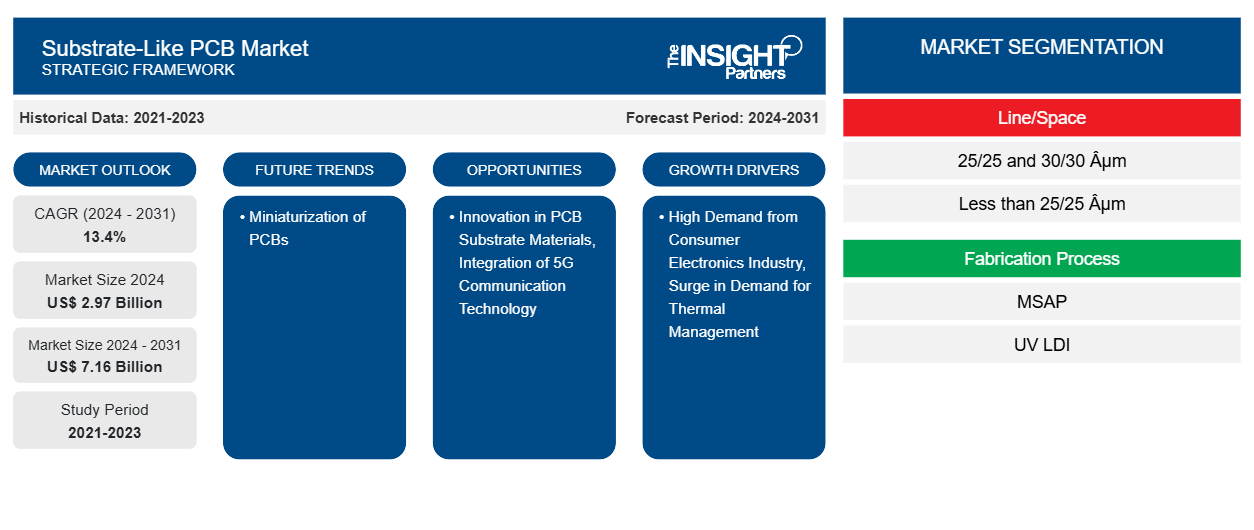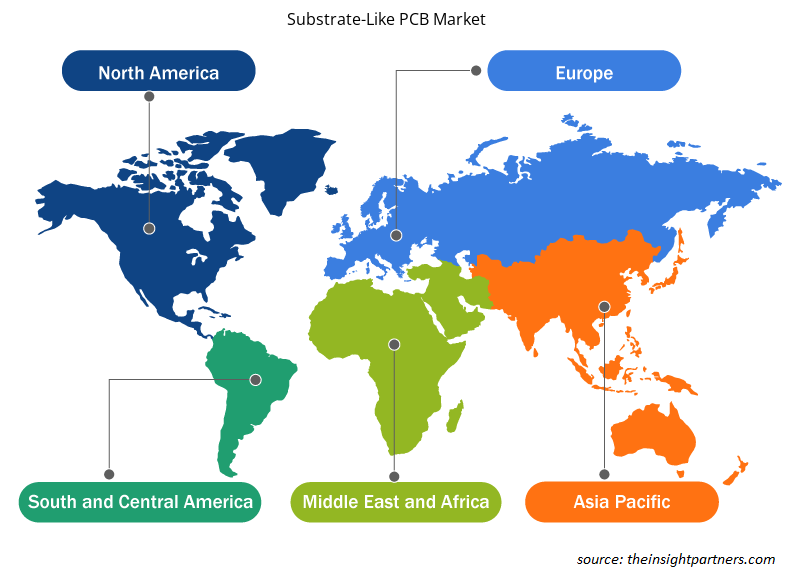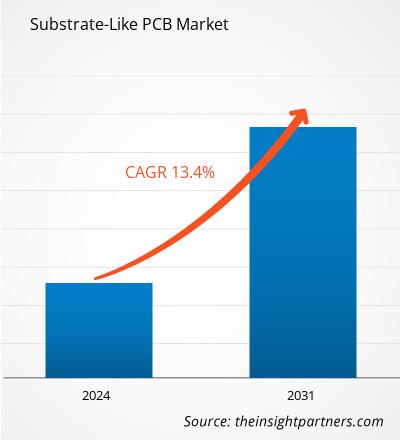Der Markt für substratähnliche Leiterplatten wird voraussichtlich von 2,97 Milliarden US-Dollar im Jahr 2024 auf 7,16 Milliarden US-Dollar im Jahr 2031 anwachsen. Für den Zeitraum 2024–2031 wird eine durchschnittliche jährliche Wachstumsrate (CAGR) von 13,4 % erwartet. Die Miniaturisierung von Leiterplatten dürfte in den kommenden Jahren neue Trends auf den Markt bringen.
Marktanalyse für substratähnliche Leiterplatten
Eine substratähnliche Leiterplatte (SLP oder substratähnliche Leiterplatte) weist ähnliche Eigenschaften wie ein Halbleitersubstrat auf. Diese Leiterplatte wurde für fortschrittliche IC-Verpackungen und Anwendungen mit ultrahoher Dichte entwickelt. Substratähnliche Leiterplatten vereinen Merkmale sowohl herkömmlicher Leiterplatten als auch von Halbleitersubstraten, um die Anforderungen der Verbraucher an moderne Elektronik zu erfüllen. Sie werden häufig in Hochleistungsanwendungen wie Smartphones, Wearables, Computern, Bremssystemen, ADAS und anderer fortschrittlicher Unterhaltungselektronik eingesetzt, um deren Leistung zu verbessern. Substratähnliche Leiterplatten bieten hochdichte, leistungsstarke und kompakte Designs und erfüllen die Anforderungen moderner, miniaturisierter Elektronik. Darüber hinaus haben die erheblichen Vorteile substratähnlicher Leiterplatten, wie z. B. Wärmemanagement, hochdichte Verbindungen und Signalintegrität durch Reduzierung elektromagnetischer Interferenzen (EMI), ihre Verbreitung in der Industrie verstärkt. Unterhaltungselektronik, Automobilindustrie, Medizin, Industrie, Luft- und Raumfahrt und andere Branchen nutzen substratähnliche Leiterplatten, um die elektrische Leistung von Geräten und Systemen zu verbessern und so den Markt voranzutreiben.
Marktübersicht für substratähnliche Leiterplatten
Die steigende Nachfrage aus der Unterhaltungselektronikbranche, die Kundennachfrage nach Wärmemanagement, die expandierende Automobilindustrie und der Fokus der Hersteller auf die Produktion von Elektrofahrzeugen und autonomen Autos sind einige der wichtigen Faktoren, die den Markt für substratähnliche Leiterplatten antreiben . Darüber hinaus treiben steigende Investitionen in Smartphones, Wearables und Wireless-Technologie die globale Nachfrage nach substratähnlichen Leiterplatten an. Darüber hinaus sind innovative Materialien, die in Leiterplattensubstraten verwendet werden, wie Epoxidharz, Polytetrafluorethylen (PTFE), Glasfasergewebe, flexible Polymere und andere dielektrische und isolierende Materialien, die die Wärmeentwicklung reduzieren, sowie die Integration der 5G-Kommunikationstechnologie in Geschäftsmodelle einige Faktoren, die im Prognosezeitraum voraussichtlich Chancen für das Wachstum des Marktes für substratähnliche Leiterplatten schaffen. Darüber hinaus ermutigen verstärkte Forschungs- und Entwicklungsaktivitäten, die Miniaturisierung von Leiterplatten und die industrielle Nachfrage nach Leiterplatten der nächsten Generation die Hersteller, sich auf die Entwicklung von Mini-Leiterplatten zu konzentrieren, was zum Wachstum des Marktes für substratähnliche Leiterplatten beiträgt.
Passen Sie diesen Bericht Ihren Anforderungen an
Sie erhalten kostenlos Anpassungen an jedem Bericht, einschließlich Teilen dieses Berichts oder einer Analyse auf Länderebene, eines Excel-Datenpakets sowie tolle Angebote und Rabatte für Start-ups und Universitäten
Markt für substratähnliche Leiterplatten: Strategische Einblicke

- Informieren Sie sich über die wichtigsten Markttrends in diesem Bericht.Dieses KOSTENLOSE Beispiel umfasst eine Datenanalyse, die von Markttrends bis hin zu Schätzungen und Prognosen reicht.
Treiber und Chancen des Marktes für substratähnliche Leiterplatten
Steigende Nachfrage nach Wärmemanagement
Das Wärmemanagement stellt auf Leiterplattenebene und in der Baugruppe ein zunehmendes Problem dar, insbesondere bei Hochleistungs- und Hochspannungsanwendungen, bei denen eine bessere Wärmeübertragung und Kühlung unerlässlich ist. Substratähnliche Leiterplatten werden aus Polyimid, Bismaleimid-Triazin-Harz (BT) und glasfaserverstärktem Epoxidharz (FR-4) hergestellt, die eine bessere Wärmeleitfähigkeit als andere Leiterplattenmaterialien aufweisen. Viele Branchen setzen substratähnliche Leiterplatten häufig zur verbesserten Wärmeableitung von elektronischen Bauteilen ein, was die Wärmeleitfähigkeit verbessert und die Gerätezuverlässigkeit und -lebensdauer erhöht. Beispiele:
In der Unterhaltungselektronikbranche werden substratähnliche Leiterplatten in High-End-Smartphones, Laptops und Spielekonsolen eingesetzt, um die Wärmeentwicklung von Prozessoren, Grafikprozessoren (GPUs) und Netzteilen zu reduzieren. Das Innenleben dieser Geräte wird immer komplexer, was eine Kontrolle der von leistungsstarken Chips erzeugten Wärme sowie die Aufrechterhaltung ihrer Leistung und Haltbarkeit erforderlich macht. Beispielsweise werden substratähnliche Leiterplatten in Hochleistungs-Smartphones eingesetzt, um die von Prozessoren erzeugte Wärme effizient zu regulieren und sicherzustellen, dass das Gerät auch beim Video-Streaming und Spielen kühl bleibt.
Elektrofahrzeuge (EVs) und autonome Fahrsysteme sind in hohem Maße auf substratähnliche Leiterplatten angewiesen, um die thermische Stabilität ihrer Elektronik, insbesondere der Leistungselektronik und der Batteriemanagementsysteme, zu gewährleisten. Gekühlte Leistungsmodule in Elektrofahrzeugen sind entscheidend für die Sicherheit und Leistung des Batteriesystems. Darüber hinaus werden substratähnliche Leiterplatten in der Automobilindustrie für das Wärmemanagement von Batterieladegeräten, Wechselrichtern und Motorsteuerungen in Elektroautos eingesetzt.
In der Telekommunikationsbranche erfordern einige Prozesse Hochfrequenzübertragungen, bei denen Leistungsverstärker erhebliche Wärme erzeugen. Dies erhöht den Bedarf an substratähnlichen Leiterplatten zur Verbesserung des Wärmemanagements. Dies ist besonders wichtig in Basisstationen und Kommunikationszentren, wo Ausfallzeiten zu erheblichen Betriebsstörungen führen können. Beispielsweise benötigen Basisstationen für 5G-Netze ein hocheffizientes Wärmemanagement für Leistungsverstärker und Hochfrequenzkomponenten.
In der Medizinbranche ist Wärmemanagement entscheidend für die Verbesserung der Geräteleistung und die Patientensicherheit. Substratähnliche Leiterplatten bieten eine zuverlässige Möglichkeit, empfindliche medizinische Geräte während des Betriebs kühl zu halten. Beispielsweise nutzen moderne Diagnosegeräte wie Magnetresonanztomographen (MRT) und tragbare medizinische Geräte substratähnliche Leiterplatten zur Temperaturkontrolle, um Überhitzung zu vermeiden und die Lebensdauer der Geräte zu verlängern.
Substratähnliche Leiterplatten bieten erhebliche Vorteile für industrielle Anwendungen, wie z. B. die Miniaturisierung von Produkten, verbesserte Leistung sowie verbesserte thermische und mechanische Eigenschaften. Dies erhöht die Nachfrage in verschiedenen Branchen, darunter Unterhaltungselektronik, Automobilindustrie, Medizin, Telekommunikation und Luft- und Raumfahrt. Der Anstieg der Nachfrage nach Wärmemanagement treibt daher das Marktwachstum für substratähnliche Leiterplatten voran.
Innovation bei PCB-Substratmaterialien
Traditionelle Materialien wie Keramik dienten bisher als Grundlage für Leiterplatten. In jüngster Zeit stehen Leiterplatten im Zentrum der Innovation in der Elektronikindustrie. In dieser dynamischen Branche haben sich Leiterplattensubstrate wie Epoxidharz, Polytetrafluorethylen (PTFE), Glasfasergewebe, flexible Polymere und andere dielektrische und isolierende Materialien von traditionellen Materialien zu Nanokompositen entwickelt. Diese Materialien bieten mechanischen Halt und elektrische Isolierung für die Leiterplattenkomponenten. Leiterplattensubstrate dienen als Grundlage für die Montage von Leiterbahnen und elektronischen Komponenten und unterstützen die Leiterbahnen, die den elektrischen Impulsfluss durch die Schaltung ermöglichen. Da sich Elektronikhersteller auf die Entwicklung fortschrittlicher Geräte konzentrieren, nimmt die Nutzung von Leiterplattensubstraten bei Leiterplattenherstellern zu. Einige dieser innovativen Materialien sind nachfolgend aufgeführt:
Hochfrequenzmaterialien: Hochfrequenzmaterialien wie Polytetrafluorethylen (PTFE) und keramikgefüllte Kohlenwasserstoffe stellen einen bedeutenden Fortschritt in der Entwicklung von Leiterplattensubstraten dar. Diese Materialien bieten minimalen Signalverlust und verbesserte Signalintegrität, was für die Datenübertragung bei höheren Frequenzen entscheidend ist. Der Einsatz dieser Materialien ermöglicht die Herstellung von Leiterplatten, die die hohen Datenraten der nächsten Generation der drahtlosen Kommunikation und anderer Hochfrequenzanwendungen bewältigen können.
Flexible und starrflexible Substrate: Die Einführung flexibler und starrflexibler Substrate, üblicherweise aus Polyimid, ermöglicht die Biegung von Leiterplatten oder die Anpassung an nicht-ebene Oberflächen und eröffnet so potenzielle Einsatzmöglichkeiten für tragbare Geräte. Starrflexible Substrate vereinen flexible und starre Materialien auf einer einzigen Platte und erreichen so ein Gleichgewicht zwischen Flexibilität und struktureller Integrität. Diese Erfindung verändert das Produktdesign und ermöglicht die Entwicklung faltbarer Smartphones, flexibler Displays und anderer kleiner Elektroprodukte.
Nanokompositmaterialien: Nanokompositmaterialien verbessern Leiterplattensubstrate durch die Zugabe von Nanopartikeln zum Basismaterial. Diese typischerweise kohlenstoffbasierten Nanopartikel verbessern die mechanische Festigkeit, die Wärmeleitfähigkeit und die elektrischen Eigenschaften und verleihen Leiterplatten dadurch eine bessere Leistung, geringere Größe und höhere Zuverlässigkeit. Darüber hinaus sind Nanokomposite besonders nützlich in der Luft- und Raumfahrt sowie in der Medizintechnik, wo Größe und Gewicht entscheidend sind. Mit der Weiterentwicklung der Materialtechnologie steigt die Integration von Nanokompositmaterialien in Leiterplattensubstrate, was die Effizienz und Leistung elektronischer Geräte weiter steigert.
PCB-Substrate dienen als Rahmen für die präzise Integration elektronischer Komponenten und ermöglichen die Herstellung anspruchsvoller Schaltungen für eine Vielzahl elektronischer Geräte, darunter Smartphones, Tablets und Industriemaschinen. Innovationen bei PCB-Substratenmaterialien dürften daher im Prognosezeitraum Chancen für das Marktwachstum substratähnlicher PCBs schaffen.
Segmentierungsanalyse des Marktberichts für substratähnliche Leiterplatten
Wichtige Segmente, die zur Ableitung der Marktanalyse für substratähnliche Leiterplatten beigetragen haben, sind Linie/Abstand, Herstellungsprozess und Anwendung.
- Basierend auf dem Linien-/Abstandsverhältnis ist der Markt für substratähnliche Leiterplatten in 25/25 und 30/30 µm sowie weniger als 25/25 µm unterteilt. Das 25/25- und 30/30-µm-Segment hatte im Jahr 2024 einen größeren Marktanteil.
- Basierend auf dem Herstellungsprozess ist der Markt für substratähnliche Leiterplatten in MSAP und UV-LDI unterteilt. Das MSAP-Segment hatte im Jahr 2024 den größten Marktanteil.
- Der Markt für substratähnliche Leiterplatten ist nach Anwendung in die Bereiche Unterhaltungselektronik, Automobil, Industrie, Medizin und Sonstige unterteilt. Das Segment Sonstige hielt im Jahr 2024 den größten Marktanteil.
Substratähnliche PCB Marktanteilsanalyse nach Geografie
Der geografische Umfang des Marktberichts für substratähnliche Leiterplatten ist hauptsächlich in fünf Regionen unterteilt: Nordamerika, Asien-Pazifik, Europa, Naher Osten und Afrika sowie Süd- und Mittelamerika.
Der asiatisch-pazifische Raum hielt 2023 einen bedeutenden Marktanteil. Die Entwicklung der 5G-Netzwerkinfrastruktur und die Nachfrage der Industrie nach mehrschichtigen Leiterplatten ermutigen die Marktteilnehmer, ihre Produktion zu steigern und maßgeschneiderte Leiterplatten zu entwickeln, um die dynamischen Bedürfnisse ihrer Kunden zu erfüllen. Regierungsinitiativen und der Fokus auf die Sensibilisierung für die Vorteile substratähnlicher Leiterplatten treiben das Marktwachstum voran. So verlieh das China Intellectual Property Office im April 2022 Shenzhen Kinwong Electronic Co., Ltd. den China Patent Excellence Award für die Entwicklung eines Herstellungsverfahrens und einer mehrschichtigen Leiterplatte. Diese mehrschichtigen Leiterplatten werden häufig in 5G-Basisstationen, Datenspeichern, Servern, Switching-Routern, Satellitensystemen, industriellen Steuerungen und medizinischen Geräten eingesetzt. Darüber hinaus ermutigt die wachsende industrielle Nachfrage nach mehrschichtigen Leiterplatten Shenzhen Kinwong Electronic Co., Ltd., eine Vielzahl von mehrschichtigen Produkten mit erheblichen Industrialisierungsvorteilen herzustellen und herzustellen.
Der Markt für substratähnliche Leiterplatten in Südkorea wird im Prognosezeitraum voraussichtlich wachsen, da Regierung und Marktteilnehmer verstärkt auf die Förderung der Elektronikfertigung setzen. So veranstaltete IPC International, Inc. am 29. Oktober 2024 in Seoul das PC K-FEST 2024, das zweite jährliche IPC Korea Festival of Electronics Standards and Technology Seminar. Das Seminar widmete sich den Herausforderungen der Elektronikfertigung und demonstrierte, wie IPC-Standards die Fertigungsleistung und -qualität verbessern. Darüber hinaus konzentrieren sich Marktteilnehmer auf den Ausbau ihres Geschäfts in Südkorea, um neue Kunden zu gewinnen, was im Prognosezeitraum voraussichtlich Marktchancen eröffnen wird. So gründete Xiaomi am 6. Januar 2024 eine neue Tochtergesellschaft und eine Reihe von Smart-Geräten, darunter Smartphones, Wearables, Fernseher, Powerbanks und Roboterstaubsauger, um seine Präsenz in Südkorea auszubauen. Diese Produkte unterstützen Xiaomi dabei, die vielfältigen Verbraucherbedürfnisse von preisgünstigen bis hin zu Premium-Geräten zu erfüllen. Mit der zunehmenden Kompaktheit und Miniaturisierung elektronischer Geräte steigt auch die Nachfrage nach kleineren und effizienteren Leiterplatten. Smartphones, Tablets, Wearables und IoT-Geräte verwenden allesamt substratähnliche Leiterplatten für ihre hochdichte Verpackung.
Regionale Einblicke in den Markt für substratähnliche Leiterplatten
Die Analysten von Insight Partners haben die regionalen Trends und Faktoren, die den Markt für substratähnliche Leiterplatten im Prognosezeitraum beeinflussen, ausführlich erläutert. Dieser Abschnitt behandelt außerdem die Marktsegmente und die geografische Lage für substratähnliche Leiterplatten in Nordamerika, Europa, Asien-Pazifik, dem Nahen Osten und Afrika sowie Süd- und Mittelamerika.

- Erhalten Sie regionale Daten zum Markt für substratähnliche Leiterplatten
Umfang des Marktberichts über substratähnliche Leiterplatten
| Berichtsattribut | Details |
|---|---|
| Marktgröße im Jahr 2024 | 2,97 Milliarden US-Dollar |
| Marktgröße bis 2031 | 7,16 Milliarden US-Dollar |
| Globale CAGR (2024 – 2031) | 13,4 % |
| Historische Daten | 2021-2023 |
| Prognosezeitraum | 2024–2031 |
| Abgedeckte Segmente | Nach Zeile/Abstand
|
| Abgedeckte Regionen und Länder | Nordamerika
|
| Marktführer und wichtige Unternehmensprofile |
|
Marktteilnehmerdichte für substratähnliche Leiterplatten: Auswirkungen auf die Geschäftsdynamik
Der Markt für substratähnliche Leiterplatten wächst rasant. Die steigende Endverbrauchernachfrage ist auf Faktoren wie veränderte Verbraucherpräferenzen, technologische Fortschritte und ein stärkeres Bewusstsein für die Produktvorteile zurückzuführen. Mit der steigenden Nachfrage erweitern Unternehmen ihr Angebot, entwickeln Innovationen, um den Verbraucherbedürfnissen gerecht zu werden, und nutzen neue Trends, was das Marktwachstum weiter ankurbelt.
Die Marktteilnehmerdichte beschreibt die Verteilung der in einem bestimmten Markt oder einer bestimmten Branche tätigen Unternehmen. Sie gibt an, wie viele Wettbewerber (Marktteilnehmer) in einem bestimmten Marktraum im Verhältnis zu dessen Größe oder Gesamtmarktwert präsent sind.
Die wichtigsten Unternehmen, die auf dem Markt für substratähnliche Leiterplatten tätig sind, sind:
- Compeq Manufacturing Co., Ltd.
- Kinsus Interconnect-Technologie
- Samsung Electro-Mechanics Co Ltd
- AT & S Austria Technologie & Systemtechnik Aktiengesellschaft
- Zhen Ding Tech. Group Technology Holding Limited
- TTM Technologies Inc.
Haftungsausschluss : Die oben aufgeführten Unternehmen sind nicht in einer bestimmten Reihenfolge aufgeführt.

- Erhalten Sie einen Überblick über die wichtigsten Akteure auf dem Markt für substratähnliche Leiterplatten
Neuigkeiten und aktuelle Entwicklungen zum Markt für substratähnliche Leiterplatten
Der Markt für substratähnliche Leiterplatten wird durch die Erhebung qualitativer und quantitativer Daten aus Primär- und Sekundärforschung bewertet. Dazu zählen wichtige Unternehmenspublikationen, Verbandsdaten und Datenbanken. Nachfolgend sind einige Entwicklungen im Markt für substratähnliche Leiterplatten aufgeführt:
- Die ICAPE Group gab die Unterzeichnung eines Vertrags zur Übernahme von 100 % des Kapitals der japanischen NTW-Gruppe bekannt, die auf den Vertrieb von Leiterplatten in Asien spezialisiert ist. Der Zugang zur globalen Logistikplattform der ICAPE Group ermöglicht es NTW, seinen Kunden neue Dienstleistungen anzubieten, sein Produktangebot zu erweitern und so das profitable Wachstum zu steigern. (Quelle: ICAPE Group, Pressemitteilung, September 2024)
- Das chinesische Amt für geistiges Eigentum gab die Ergebnisse des 23. China Patent Awards bekannt. Kinwongs Verfahren zur Herstellung mehrschichtiger Leiterplatten und die dazugehörigen mehrschichtigen Leiterplatten wurden mit dem China Patent Excellence Award ausgezeichnet. Der China Patent Award wird gemeinsam vom chinesischen Amt für geistiges Eigentum und der Weltorganisation für geistiges Eigentum (WPO) gesponsert. (Quelle: Shenzhen Kinwong Electronic Co., Ltd., Pressemitteilung, April 2022)
Marktbericht zu substratähnlichen Leiterplatten: Abdeckung und Ergebnisse
Der Bericht „Marktgröße und Prognose für substratähnliche Leiterplatten (2021–2031)“ bietet eine detaillierte Analyse des Marktes, die die folgenden Bereiche abdeckt:
- Marktgröße und Prognose für substratähnliche Leiterplatten auf globaler, regionaler und Länderebene für alle wichtigen Marktsegmente, die im Geltungsbereich abgedeckt sind
- Markttrends für substratähnliche Leiterplatten sowie Marktdynamiken wie Treiber, Einschränkungen und wichtige Chancen
- Detaillierte PEST- und SWOT-Analyse
- Marktanalyse für substratähnliche Leiterplatten, die wichtige Markttrends, globale und regionale Rahmenbedingungen, wichtige Akteure, Vorschriften und aktuelle Marktentwicklungen umfasst
- Branchenlandschaft und Wettbewerbsanalyse mit Marktkonzentration, Heatmap-Analyse, prominenten Akteuren und aktuellen Entwicklungen für den Markt für substratähnliche Leiterplatten
- Detaillierte Firmenprofile
- Historische Analyse (2 Jahre), Basisjahr, Prognose (7 Jahre) mit CAGR
- PEST- und SWOT-Analyse
- Marktgröße Wert/Volumen – Global, Regional, Land
- Branchen- und Wettbewerbslandschaft
- Excel-Datensatz
Aktuelle Berichte
Erfahrungsberichte
Grund zum Kauf
- Fundierte Entscheidungsfindung
- Marktdynamik verstehen
- Wettbewerbsanalyse
- Kundeneinblicke
- Marktprognosen
- Risikominimierung
- Strategische Planung
- Investitionsbegründung
- Identifizierung neuer Märkte
- Verbesserung von Marketingstrategien
- Steigerung der Betriebseffizienz
- Anpassung an regulatorische Trends






















 Kostenlose Probe anfordern für - Markt für substratähnliche Leiterplatten
Kostenlose Probe anfordern für - Markt für substratähnliche Leiterplatten